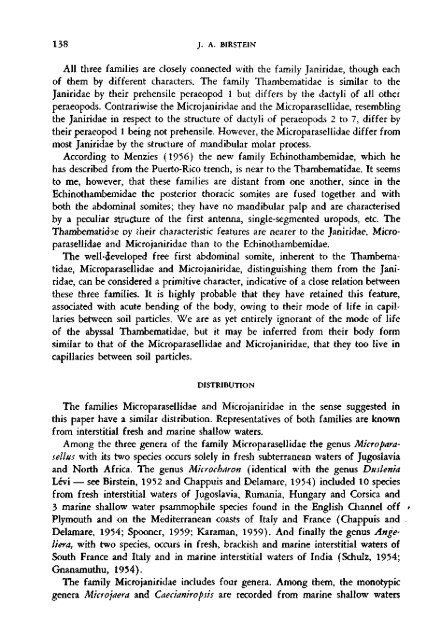MICROTHAMBEMA TENUIS N. GEN., N. SP. (ISOPODA ASELLOTA ...
MICROTHAMBEMA TENUIS N. GEN., N. SP. (ISOPODA ASELLOTA ...
MICROTHAMBEMA TENUIS N. GEN., N. SP. (ISOPODA ASELLOTA ...
Create successful ePaper yourself
Turn your PDF publications into a flip-book with our unique Google optimized e-Paper software.
138 J. A. BIRSTE1N<br />
All three families are closely connected with the family Janiridae, though each<br />
of them by different characters. The family Thambematidae is similar to the<br />
Janiridae by their prehensile peraeopod 1 but differs by the dactyli of all other<br />
peraeopods. Contrariwise the Microjaniridae and the Microparaselhdae, resembling<br />
the Janiridae in respect to the structure of dactyli of peraeopods 2 to 7, differ by<br />
their peraeopod 1 being not prehensile. However, the Microparaselhdae differ from<br />
most Janiridae by the structure of mandibular molar process.<br />
According to Menzies (1956) the new family Echinothambemidae, which he<br />
has described from the Puerto-Rico trench, is near to the Thambematidae, It seems<br />
to me, however, that these families are distant from one another, since in the<br />
Echinothambemidae the posterior thoracic somites are fused together and with<br />
both the abdominal somites; they have no mandibular palp and are characterised<br />
by a peculiar structure 0f the first antenna, single-segmented uropods, etc. The<br />
Thambematid'ie oy their characteristic features are nearer to the Janiridae, Microparasellidae<br />
and Microjaniridae than to the Echinothambemidae.<br />
The well-developed free first abdominal somite, inherent to the Thambematidae,<br />
Microparasellidae and Microjaniridae, distinguishing them from the Janiridae,<br />
can be considered a primitive character, indicative of a dose relation between<br />
these three families. It is highly probable that they have retained this feature,<br />
associated with acute bending of the body, owing to their mode of life in capillaries<br />
between soil particles. We are as yet entirely ignorant of the mode of life<br />
of the abyssal Thambematidae, but it may be inferred from their body form<br />
similar to that of the Microparasellidae and Microjaniridae, that they too live in<br />
capillaries between soil particles.<br />
DISTRIBUTION<br />
The families Microparasellidae and Microjaniridae in the sense suggested in<br />
this paper have a similar distribution. Representatives of both families are known<br />
from interstitial fresh and marine shallow waters.<br />
Among the three genera of the family Microparasellidae the genus Mkroparasellus<br />
with its two species occurs solely in fresh subterranean waters of Jugoslavia<br />
and North Africa. The genus Microebaron (identical with the genus Duslenia<br />
Levi — see Birstein, 1952 and Chappuis and Delamare, 1954) included 10 species<br />
from fresh interstitial waters of Jugoslavia, Rumania, Hungary and Corsica and<br />
3 marine shallow water psammophile species found in the English Channel off •<br />
Plymouth and on the Mediterranean coasts of Italy and France (Chappuis and<br />
Delamare, 1954; Spooner, 1959; Karaman, 1959). And finally the genus Ange-<br />
Hera, with two species, occurs in fresh, brackish and marine interstitial waters of<br />
South France and Italy and in marine interstitial waters of India (Schulz, 1954;<br />
Gnanamuthu, 1954).<br />
The family Microjaniridae includes four genera. Among them, the monotypic<br />
genera Mkropera and Caerianiropsis are recorded from marine shallow waters
















